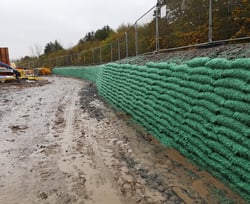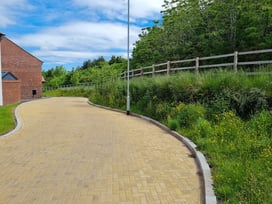General maintenance based on Hydroseeding on Rootlok retaining walls
Our standard seed mix will provide a minimum / low maintenance program, special seed mixes can be chosen by the consultant to suit their particular applications, due attention to watering particularly in early periods after hydroseeding and in prolonged dry spells to help establish early growth and stop seed die-off.
The vegetation must be left to establish without any cutting or trimming throughout the first year. Nursery grasses will quickly grow giving initial coverage with other grass types following on to give up to 80% coverage by the end of the first growing season if wildflower seed has been used it will not show until the middle-end of the second year.

- Hydroseeding will be done immediately on completion of the wall.
- The standard seed mix is based on a distribution 30g per m2 to achieve low maintenance system.
- If hydroseeding takes place during a winter period, the seeds will lie dormant and protected in the mulch and germinate in spring / early summer depending on climate.
- If hydroseeding takes place during spring / early summer grass growth will establish quickly & continue to populate the system until winter months.
- Weed control shall be required during the early years of vegetation establishment and infestations of injurious weeds and large tree species must be removed.
Year 1
- If hydroseeded during the winter period seeds will germinate in spring (March-April) dependent on weather conditions.
- Grass will quickly establish during the spring and continue to establish through the summer months.
- Watering should be regular during summer months or prolonged dry spells.
- An inspection should be done to remove any unwanted weeds and large tree species self-sets – removed by hand in late summer (September-October)
- Grasses should be allowed to continue to grow and establish without cutting during year 1.
- Natural dieback occurs during the winter period.
Year 2
- Grasses will continue to grow from spring onwards.
- Other types of grasses from within the seed mix will start to populate the system.
- If vegetation has not taken place, please notify Geogrow. If required, Geogrow can provide a light spring dressing of mulch containing slow release of fertilizer to accelerate grass growth.
- If wildflower exist in the seedmix they will slowly establish in the later part of the second year and provide extra pollinators for insects, bees, and butterflies.
- Watering should be regular during summer months or prolonged dry spells.
- Two inspections shall be required in year 2 – one early summer, Rootlok is designed to allow only small root systems to develop within the bag structure, all weeds and large self-set trees must be removed by hand.
- Inspection 2 should be done late summer (September-October) and unwanted vegetation removed.
- If required, grasses can be cut by strimming (Rootlok is a geotextile bag system and strimming should be done 150mm away from the bag system).
- If the wall is not customer facing the vegetation may be left to nature, die back will take place and regrowth will take place annually to create a sustainable green finish, adding to the ecosystem and provide continued wildlife habitat.
Year 3
-
Grasses, wildflowers, and plants will continue to grow strongly throughout the system and provide a more natural colorful environment will establish.
-
Weeds should be lessened as the grasses, wildflowers and plants populate the full wall system.
-
One inspection will be required in year 3 (mid-summer) to remove of any set-sets and selective weeding, if deemed necessary.
-
Grass cutting may be required once or twice during year 3 and onwards to keep tidy, If required.
-
Grasses can be cut by strimming (Rootlok is a geotextile bag system and strimming should be done 150mm away from the bag system).
-
If the wall is not customer facing the vegetation may be left to nature, die back will take place and regrowth will take place annually to create a sustainable green finish, adding to the ecosystem and provide continued wildlife habitat.
Ongoing General Maintenance
- General Inspection – 6 &12 monthly intervals
- Grass Cutting - Minimal frequency, as required to keep tidy.
- - Wildflower Areas - Nature Conservation Value cut where necessary.
- Selected weed Control – By hand weeding.
- Other weed control shall be required in the locations and at the frequencies for infestations of injurious weeds.
- Medium and large self-Set trees plus larger shrubs to be removed ASAP.
- Self-set variety of grasses, wildflower and plants should only be removed if deemed undesirable.
- Wildlife inspection / control – Burrowing animals.
- Rabbits, badgers, fox and other burrowing mammals are to be clearly identified, marked and the locations shall be reported and dealt with under controlled operations.
- If wildlife establishes habitats within Rootlok system, it will not affect the overall structural strength of the wall but should be reported to the manufacturer for guidance.
- Watering – Generally only required in prolonged periods of drought.
Structural Inspection
Recommended once every 20 years OR follow the guidance of the Local Authorities OR policy for inspection on retaining wall structures.
On visual inspection should there be any structural defects, subsidence or vegetation matters - report the location immediately to the maintenance team and inform the manufacturer Geogrow Ltd for advice.
Grass Cutting
Grass cutting is to be done so that no damage is caused to the bag system, low level strimmer’s may be used to cut the grass150mm away from the face of the Rootlok bags.
A-boom attachment using Rotary Cutting Heads can be used on mid to high wall and slopes avoiding damage to the bags by cutting150mm away from the bag system.
Self-set trees, injurious weeds, larger shrubs, and plants are to be detected at an early growth stage and removed.
Watering
Under general UK weather conditions with regular rain patterns watering is generally not required.
Watering will be required during prolonged periods of drought.
Using a medium sprayed water pressure to reach all areas of the wall / vegetation via the use of small mobile equipment or spraying truck to water at regular intervals, if required.
